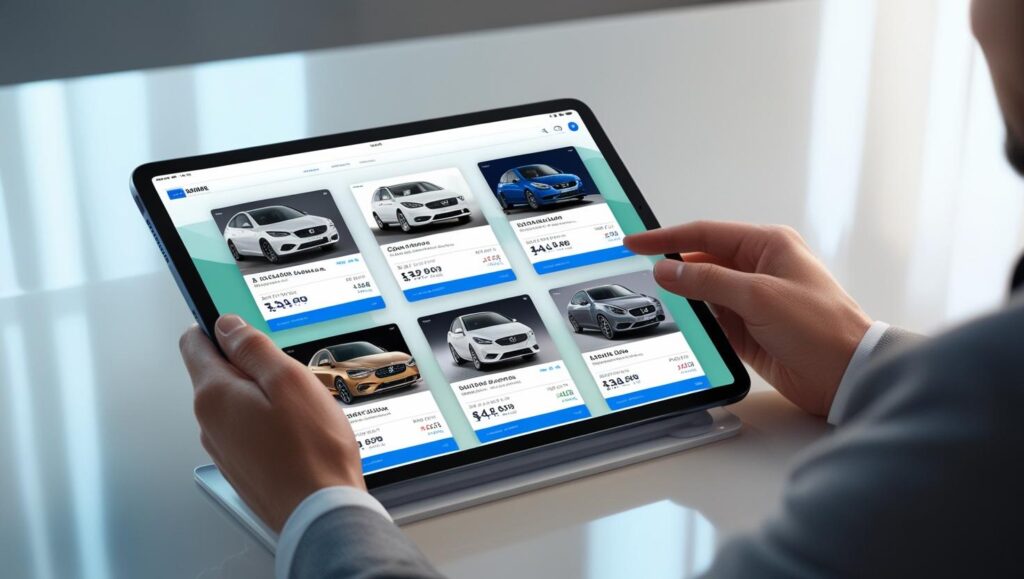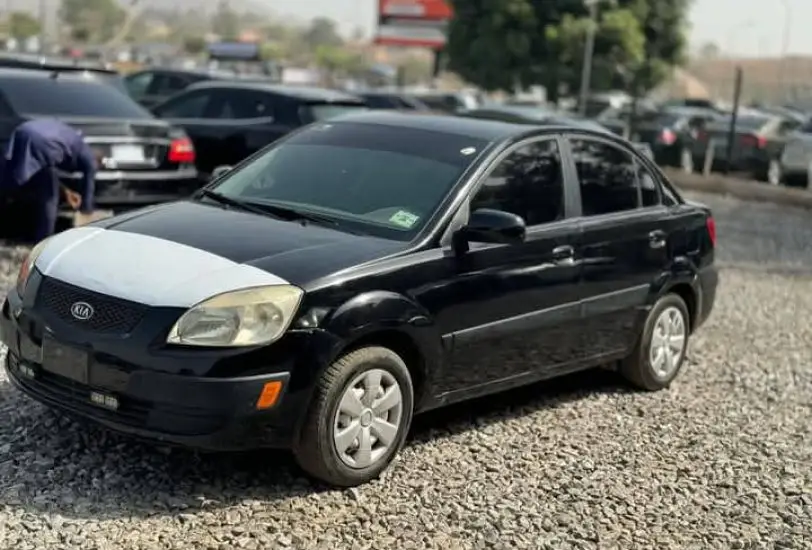The way we buy cars has fundamentally changed. Gone are the days when visiting multiple dealerships was the only option. Today, digital showrooms, online research, and even complete online purchases are reshaping the automotive landscape. Understanding the key online car buying statistics is crucial for consumers, dealers, and manufacturers navigating this evolution in 2025.
This post dives deep into the data, compiling over 50 essential statistics that reveal the current state and future trajectory of buying vehicles online. From market size and growth rates to consumer demographics and behavior, here are the numbers driving the digital transformation in car sales.
Top Online Car Buying Statistics for 2025 (Editor’s Picks)
Get up to speed quickly with these crucial online car buying stats:
- Global Market Value: The global online car buying market is estimated to reach $370.70 Billion in 2025.
- Impressive Growth: This market is projected to surge at a Compound Annual Growth Rate (CAGR) of 12.7% between 2025 and 2032, potentially reaching $856.57 Billion.
- Online Purchase Intent: Around 25-30% of consumers state they are interested in or plan to purchase their next vehicle entirely online.
- Used Cars Dominate Online: Pre-owned vehicles account for the largest share of the online car buying market, estimated at 67.9% in 2025.
- Research is Overwhelmingly Online: Over 90-95% of all car buyers conduct extensive online research before ever stepping into a dealership.
- Younger Buyers Lead: Consumers under 40 are significantly more likely, potentially twice as likely, to purchase a vehicle online compared to those over 57.
- Dealer Adaptation: Approximately 39% of car dealers now offer the capability for consumers to complete the entire purchase process online.
- Mobile is Key: Over 70% of automotive internet shoppers use a mobile device during their car-buying journey.
Online Car Buying Market Size & Growth Statistics
The shift to digital car purchasing represents a significant economic force. Market analysis reveals substantial value and strong future potential.
Global Market Value & Projections
Multiple market research firms track this rapidly expanding sector. Coherent Market Insights estimates the global online car buying market size at $370.70 Billion in 2025. They project robust growth, forecasting a market value of $856.57 Billion by 2032, driven by a strong 12.7% CAGR. Other sources, like Market Research Future, suggest slightly more conservative figures, estimating $276.78 Billion in 2025 with a 7.21% CAGR reaching $518 Billion by 2034. While exact figures vary, the upward trend is undeniable.
US Market Dynamics
In the United States, the trend is similar. IBISWorld estimates the market size for Online Car Dealers in the US to reach $52.7 Billion in 2025, representing a 3.5% growth rate for the year.
Key Growth Drivers
Several factors fuel this expansion:
- Unmatched Convenience: Browse, comparing, and even financing vehicles from home saves significant time.
- Price Transparency: Online platforms often offer fixed pricing or clearer cost breakdowns, reducing negotiation stress.
- Wider Selection: Buyers gain access to inventory beyond their local area.
- Advanced Digital Tools: Sophisticated vehicle configurators, virtual tours (VR), and seamless online financing applications enhance the experience.
- Pandemic Acceleration: Health concerns and lockdowns significantly accelerated consumer adoption of online purchasing habits.
Online Car Purchase Adoption Statistics
While nearly everyone researches online, how many are actually clicking “buy”? The statistics show a growing, but still developing, adoption rate for full online transactions.

How Many Consumers Buy Online?
- Actual Purchase Rate: Historically, the percentage of consumers who have completed the entire car purchase online remains relatively low, with some sources citing figures under 3%.
- Growing Interest: However, intent is much higher. Around 29-30% of buyers express interest in a fully online experience for their next vehicle purchase. A significant 80% of buyers wish to complete more steps of the process from home.
- The Pandemic Push: Online purchases saw a jump during the pandemic, rising from perhaps 7% pre-2020 to around 12% in 2020, normalizing but continuing to grow since.
Online Share of Sales
- Overall Projection: Some analysts predicted online sales could represent up to 25% of the global market share by 2025.
- Used Car Online Share: The impact is particularly noticeable in the used car segment. Online channels are projected to grow rapidly, with one source suggesting they could handle over 26% of used car transactions by 2025.
Demographics of Online Car Buyers: Statistics & Trends
Who is most comfortable buying a car online? Age appears to be the most significant demographic factor.
Age is a Key Differentiator
- Millennials & Gen Z: These digital-native generations are driving the trend. A Deloitte study found 64% of millennials would prefer to complete the entire process online if possible. 34% of Gen Z express willingness for a fully online purchase.
- Young vs. Old: Buyers under 40 are consistently shown to be far more likely to buy online than older generations. Progressive Insurance found only 26% of buyers aged 25-40 used a traditional dealership for their last purchase, compared to nearly 80% of those over 57. YouGov data showed 32% of 18-24 year-olds bought their last car online, versus just 7% of those aged 55+.
Other Demographic Factors
- Gender: For the overall US car market (online and offline combined), the gender split is nearly even, with females accounting for 51% of new car buyers and 49% of used car buyers in recent studies. Data specific to online-only buyers is less granular.
- Income: Household income influences choices. 67% of new car buyers reported incomes over $75,000, compared to 55% of used car buyers in the same bracket, suggesting budget consciousness plays a role in the used market preference.
Online Car Buying Behavior: Research & Preferences Statistics
The online journey starts long before the purchase decision. Understanding consumer behavior during this phase is critical.
The Primacy of Online Research
- Near Universal Usage: A staggering 90-95% of consumers use online resources during their car buying process.
- Top Online Activities: Buyers primarily go online to:
- Research car prices (>80%)
- Find actual cars listed for sale (75%)
- Compare different models (>70%)
- Find their current car’s trade-in value (65%)
- Locate a dealer or get dealer information (55-60%)
- Information Sources: Third-party sites (like Autotrader, CarGurus, Autokunbo.com, KBB) are used by over 80% of shoppers.
Device & Platform Usage
- Mobile First: Over 70% of automotive research happens on mobile devices.
- Omnichannel Journey: More than 70% of shoppers use at least two different devices (smartphone, tablet, computer) during their research.
- Video’s Impact: Video content is highly influential. 75% of buyers watch car-related videos, and 40% discover vehicles they hadn’t previously considered through video.
- Social Media’s Role: Over 40% use social media during research, with 25-35% reporting it significantly influenced their decision.
Key Motivations for Buying Online
Consumers choose online channels primarily for:
- Convenience: Shopping anytime, anywhere.
- Transparency: Clearer pricing and less haggling.
- Selection: Access to broader inventory.
- Efficiency: Streamlined paperwork and online financing options.
Statistics Spotlight: Online Used Car Buying
The pre-owned market is where online car buying has made its most significant inroads.
- Dominant Market Share: Used vehicles represent the largest segment of the online car buying market, estimated at 67.9% share in 2025.
- Strong Growth: The online sales channel for used cars is projected to grow significantly, with a CAGR potentially around 9.4%.
- CPO Popularity: Certified Pre-Owned (CPO) programs are increasingly popular online. They could represent 22% or more of franchised dealerships’ used car sales by 2025, up from ~15% in 2023. CPO offers provide warranty and inspection peace of mind, mitigating online purchase risks.
Statistics Spotlight: Online New Car & EV Buying
While used cars lead online volume, new car and EV sales are also adapting digitally.
- New Car Online Growth: Manufacturers are increasingly focusing on their digital storefronts and direct-to-consumer models, driving growth in online new vehicle sales. Some analyses suggest new cars might hold a larger revenue share online (~55-60%), reflecting higher transaction values.
- EV Market Dynamics:
- EV sales growth has slowed in some regions, with high prices and charging anxiety cited as concerns. EU Q1 2025 data shows Battery Electric Vehicles (BEVs) at a 15.2% market share.
- Hybrid-electric vehicles are gaining significant traction, capturing 35.5% of the EU market in Q1 2025
- Lower fuel costs remain a primary driver for EV consideration globally.
- Online Experience: New EV manufacturers often provide superior online experiences compared to traditional automakers.
The Dealership Role in an Online World: Key Statistics
Despite the digital shift, physical dealerships remain relevant, evolving into an omnichannel model.
- Hybrid Approach: While online research is near-universal, many buyers still prefer aspects of the in-person experience. 61% prefer to complete the final purchase at a dealership (EY). Around 40-45% of shoppers still make their first contact via a dealership walk-in).
- Physical Interaction: 66% still want to physically see and test drive the car. Test drives consistently receive high satisfaction ratings (81%), though F&I and paperwork drag down overall dealership satisfaction.
- The Phone Bridge: After online research, the phone is a critical link. 61% of shoppers call the dealership after an online search
Online Car Buying Challenges & Future Statistics
The path to fully digital car buying isn’t without hurdles.
- Top Consumer Concerns:
- Inability to physically inspect the vehicle before purchase remains a major barrier.
- Building trust for such a high-value online transaction is crucial.
- Future Trends & Opportunities:
- AI & Data: Expect increased use of AI for personalized recommendations, dynamic pricing, and predictive analytics in inventory management.
- Enhanced Digital Tools: Virtual Reality (VR) tours, improved online configurators, and fully integrated digital financing will become more common.
- Omnichannel Integration: Seamless transitions between online research, communication (chat, phone, email), and potential in-person visits will be key.
Conclusion: Key Takeaways on 2025 Online Car Buying Statistics
The online car buying statistics for 2025 paint a clear picture: the digital revolution in automotive retail is accelerating.
- The market is experiencing substantial growth, valued in the hundreds of billions globally.
- Younger generations are eagerly embracing online purchasing, driving future adoption.
- Online research is the standard starting point for nearly all buyers.
- The used car segment currently dominates online transactions, boosted by CPO programs.
- While fully online purchases are growing, a hybrid model blending digital convenience with key in-person dealership interactions (like test drives) remains the preference for many.
As technology advances and consumer comfort grows, online channels will become even more integral to the car buying process. Staying informed on these statistics is essential for anyone involved in the automotive world.
Sources
Coherent Market Insights (CMI) – Online Car Buying Market Report:
- (Used for: Global market size, CAGR, pre-owned segment share, challenges)
Spyne.ai – Used Cars Market Trends
- (Used for: % looking to buy online, dealership preference, physical experience importance)
Porch Group Media – Car Shopping Statistics:
- (Used for: Online research %, multi-device usage, top online activities, social media influence, F&I satisfaction, mobile usage %)
IBISWorld – Online Car Dealers US Market Size:
- (Used for: US online car dealer market size and growth rate)
ConsumerAffairs – Online Car Buying Statistics:
- (Used for: % purchased fully online, % interested in fully online, % dealers enabling full online process, Gen Z willingness)
McKinsey & Company – Online Sales/Financing Journey:
- (Used for: % wanting next car online)
YouGov (Demographics & Adoption)
Market Research Future (MRFR) – Online Car Buying Market:
- (Used for: Alternative market size/CAGR figures, new car online revenue share estimate)
- (Used for: EU Q1 2025 BEV & Hybrid market share)
Deloitte – Global Automotive Consumer Study:
- (Used for: EV concerns, lower fuel cost motivation, Millennial preference)
Invoca – Automotive Marketing Statistics:
- (Used for: % calling dealer after online search)
MHP – Online Car Sales Benchmark Analysis:
- (Used for: EV manufacturer online experience comparison)







